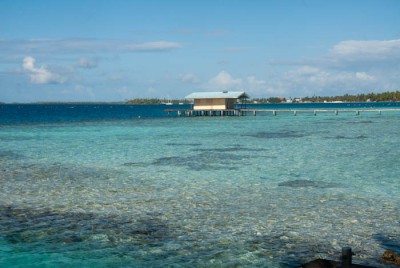Anchoring in Coral Lagoons
03 July 2013

Part of the risk of cruising in atolls is that there is an illusion of safety when you are anchored in the lee of a coral reef. There is no fetch and subsequently very little boat motion. A wonderful anchorage....that is until there is a change in the weather. When this happens and it can come unexpectedly, all of a sudden the wind can be coming from 180 degrees from when you anchored and there can be miles of open deep water in the lagoon to create large waves. That's bad enough but then what may happen is the anchor chain gets fouled on mushroom shaped coral on the seabed called "bomies" and suddenly you can loose all the catenary in your anchor chain. The chain straightens out and the shock loading sends chills down your spine. You then have to let out more chain and hopefully you have enough room to do this and avoid the reef behind you now that was previously your protector. We haven't personally experienced this and hope never to but we started thinking about this scenario after a recent anchoring episode.
A few weeks ago we had great difficulty retrieving our anchor. We had unknowingly anchored in 90 feet of water loaded with coral heads on the seabed. When we went to pull up our anchor we discovered that the chain was wrapped around mushroom shaped coral.In order to extricate the chain we had to bring the boat either to starboard or port to pull the chain away far enough to lift it with the windlass. Fortunately we didn't have to dive into the water to free ourselves. Not only did it take a lot of time but the wear and tear on the chain and windlass was painful knowing full well that if the windlass failed we were plum out of luck in the middle of nowhere. After that experience I went looking for a solution.
I remembered reading an article about how a cruiser solved this problem by suspending the majority of his chain with floats that kept the chain from lying on the bottom. He described using Pearl Farm buoys to float the chain high enough to avoid the coral. Since we were touring some Pearl Farms it seemed appropriate to buy some of their extra buoys. They have thousands of these plastic floats lying around ever since the Pearl Farm industry bottomed out years ago. They are all over the beaches on the western end of the atolls. After Nancy made a purchase I asked to buy 3 buoys and instead was given them free.
We were eager to get back to the boat and see what we could do. We secured two of these together and gingerly pulled up our anchor chain. At 60 feet (from the anchor) we attached these two floats and then let out another 50 feet of chain to see how they would work. We needed more buoyancy for the second set so I tied a fender to the third float and attached the second two floats to the chain at 110 feet letting out the final 50 feet of chain so we had 160 feet of chain out. Voilà! With no wind the first set of buoys floated about 20 feet off the bottom and the second set just barely floated very close to them. The water was so clear that we could look down the 40 feet or so to see where they were.As soon as there was any current or wind the boat pulled down the chain down, to where it needed to be but still floating above the coral heads..It was great knowing that we could leave at any time without much concern.
Every day we seem be learning new tricks to sailing problems that we have never previously encountered. This is an entirely different level of experience to coastal cruising. Fortunately there are several cruisers who are very happy to share their knowledge and experience. We've been using stearn anchors frequently to line up to the swell and retrieving them can be taxing.
Today we had a storm front come through. Ah, that will be for the next blog.
From the Crew of Always Saturday



Comments